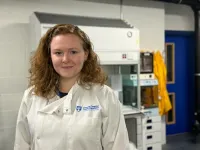(Press-News.org) Copenhagen, Denmark: Severely injured children who are brought to an emergency medical department by their parents or carers are often not seen as quickly as those who arrive at hospital via ambulance, according to findings presented at the European Emergency Medicine Congress today (Monday). [1]
The study’s researchers identified three key trauma features that should prompt doctors to review these patients immediately and potentially prioritise their treatment: boggy swelling to the head, abdominal bruising, and thigh swelling or deformity.
The study was carried out in an inner-city level 1 major trauma centre, the Bristol Royal Hospital for Children, Bristol, UK, and show that children brought in by carers were seen by emergency doctors within an average time of 58.5 minutes, ranging from 3 to 168 minutes [2].
Dr Robert Hirst, who led the study, believes the findings could be applicable to other centres that have similar pre-hospital and urgent and emergency care systems, especially as little is known generally about this group of patients.
Dr Hirst, who is an emergency medicine registrar at the hospital, told the Congress: “We see many injured children brought to the paediatric emergency department each year. Most are transported by ambulance which results in pre-hospital emergency services pre-alerting the emergency department to their arrival. This leads to early trauma team activation, resulting in specialist services and resources being ready and prepared to see these patients as soon as they arrive. This has been shown to be associated with better outcomes for children with significant injuries.
“However, we know there is a group of children who are brought by their carers who do not receive this rapid activation of resources. This can lead to delays in the appropriate level of care being provided. We wanted to find out more about these patients, their ages, the types of injuries they present with, and what happens to them. At present, little is known about this particular group of patients.”
A level 1 major trauma centre is an emergency medical centre that treats injuries that are so severe they are life-altering with a risk of death or disability, and which need immediate medical attention. Injuries can include fractures and head injuries.
Dr Hirst and colleagues looked at children aged younger than 16 years who were brought to the emergency department between 5 August 2020 and 6 May 2022 by carers, without activation of pre-hospital emergency services. During this time, 153 children with major traumas arrived; 24 of them had injuries significant enough to be added to the national Trauma Audit and Research Network (TARN) database and were included in the study. None of them received trauma team activation. All the patients still received appropriate care for their injuries, and none suffered any detrimental effects from being brought to the children’s emergency department by their parents or carers, rather than by ambulance.
The average age of the children was just over six years, and 18 (75%) were boys. Nearly all of them (23, 95.8%) had injuries to one part of their bodies, and most (22, 92%) had obvious external evidence of injury. The majority (13, 54%) had head injuries, eight (33%) had injuries to their arms or legs, and three (12.5%) had intra-abdominal injuries.
The median Injury Severity Score (a scale that measures and categorises injuries to different areas of the body) was 9, and six patients (25%) scored over 15, meaning these were injuries significant enough to be classified as major trauma. Ten (42%) of children required surgery, with seven requiring surgery for a broken thigh bone, and three needing neurosurgery to evacuate blood from swellings around the brain or to correct skull fractures. No children died.
The injuries resulted from falls (12, 50%), sporting injuries (6, 25%), bicycle injuries (2, 8%), being dropped (1, 4%), or were unexplained (3, 12.5%).
Dr Hirst said: “As always with all paediatric injuries, it is important to be aware of the possibility of non-accidental injury. Concerns for non-accidental injury were confirmed in three of our patients, all under the age of one. Consideration of non-accidental injury, robust safeguarding processes, and regular multidisciplinary governance review is vital to safeguard children attending the emergency department.”
He continued: “The most important issue highlighted in our study is a group of severely injured children facing delays to be seen by expert emergency doctors. If emergency departments adopted triage alerts for the three major signs identified by this study – boggy swelling of the head, abdominal bruising, and thigh swelling or deformity – this could prompt an urgent senior clinician review. This could improve management of this particular group of children by triggering trauma teams and appropriate allocation of resources for this high-risk population.”
Dr Hirst and his colleagues are improving processes in their department so that injured children with external evidence of injury are reviewed promptly by a senior clinical decision-maker.
“We will reassess the impact of these changes on our key performance indicators and outcomes for these children,” he concluded.
Dr Barbra Backus is chair of the EUSEM abstract selection committee. She is an emergency physician in Rotterdam, The Netherlands, and was not involved with the research. She said: “If pre-hospital emergency services have not been activated for a severely injured child, then it’s possible that the carer or emergency department medical staff may not recognise the severity of the injury immediately. This is why adoption of triage alerts for the three key features identified in this study could make a significant difference to how quickly these patients are reviewed by a senior clinician and, potentially, to their outcomes.
“Although health systems and procedures for dealing with paediatric patients who arrive at emergency medical departments by means other than an ambulance may vary from centre to centre and country to country, the findings from this study deserve close attention by emergency departments everywhere.”
(ends)
[1] Abstract no: OA004, “Identifying the walk-in wounded: a case series of paediatric major trauma patients self-presenting to a paediatric major trauma centre” by Robert Hirst et al., in the Best Abstracts oral session, 09:00-10:30 hrs CEST, Room 19.
[2] Children arriving by ambulance, or where the emergency department has been alerted before their arrival, are usually seen immediately.
END
Three key signs of major trauma could speed up treatment of severely injured children brought to emergency departments by carers not ambulances
2024-10-13
ELSE PRESS RELEASES FROM THIS DATE:
Climate change is a health emergency too
2024-10-13
Copenhagen, Denmark: International experts in emergency medicine have warned that climate change is likely to have a severe impact on emergency services around the world. Despite this, few countries have assessed the scale of the impact or have a plan to deal with it.
In a special session at the European Emergency Medicine Congress today (Sunday), Luis Garcia Castrillo, a professor in emergency medicine, now retired, at the Hospital Marqués de Valdecilla, Santander, Spain, described how he and colleagues from EUSEM’s Emergency Medicine Day working group had asked 42 focus groups, consisting of experts in emergency medicine, prehospital care ...
Chronic stress accelerates colorectal cancer progression by disrupting the balance of gut microbiota, new study shows
2024-10-12
(13 October 2024, Vienna, Austria) Cutting-edge research has uncovered how chronic stress disrupts the balance of gut microbiota to speed up the progression of colorectal cancer (CRC), opening new avenues for CRC prevention and treatment.1
By eliminating certain gut bacteria and inducing stress, researchers were able to conclude a relationship between stress and gut microbiota in the progression of CRC, identifying a particular bacterial species as a potential therapeutic target.
Presenting the study at UEG Week 2024, lead researcher Dr Qing Li explained, “In our study, we used an antibiotic ...
Brazilian study identifies potential targets for treatment of visceral leishmaniasis
2024-10-11
Researchers at the Federal University of São Carlos (UFSCar), the State University of Campinas (UNICAMP) and the University of São Paulo (USP) in Brazil have characterized for the first time a class of proteins present in the parasite Leishmania infantum and involved in regulating its cell cycle. In an article published in PLOS Pathogens, they describe potential pharmaceutical targets for the treatment of visceral leishmaniasis. Existing therapeutic strategies are considered insufficiently effective.
In eukaryotic organisms, which have cells with a defined nucleus and include all plants and animals, the ubiquitin-proteasome system (UPS) ...
Using AI and iNaturalist, scientists build one of the highest resolution maps yet of California plants
2024-10-11
With the help of deep learning, University of California, Berkeley, scientists have leveraged citizen science data from the app iNaturalist to create the highest resolution maps yet of plant distributions throughout California.
iNaturalist is a widely-used cellphone app, originally developed by UC Berkeley students, that allows people to upload photos and the location data of plants, animals or any other life they encounter and then crowdsource their identity. The app currently has more than 8 million users worldwide who collectively have uploaded more than 200 million observations.
The researchers used a ...
Researchers identify signs tied to more severe cases of RSV
2024-10-11
Respiratory syncytial virus (RSV) is the leading cause of hospitalization in young children due to respiratory complications such as bronchiolitis and pneumonia. Yet little is understood about why some children develop only mild symptoms while others develop severe disease. To better understand what happens in these cases, clinician-scientists from Brigham and Women’s Hospital, a founding member of the Mass General Brigham healthcare system, and Boston Children’s Hospital analyzed samples from patients’ airways and ...
Mays Cancer Center radiation oncologist recognized as outstanding mentor to next generation leaders
2024-10-11
SAN ANTONIO, Oct. 11, 2024 – David Gius, MD, PhD, professor in the Department of Radiation Oncology and assistant dean of research at The University of Texas Health Science Center at San Antonio (UT Health San Antonio), was named this year’s recipient of the prestigious American Society for Radiation Oncology (ASTRO) Career Recognition Mentorship Award.
Gius is associate cancer center director for translational research at Mays Cancer Center at UT Health San Antonio. He is among three awardees receiving this recognition. The award honors individuals who have made significant contributions to mentorship ...
Hitting the bull’s eye to target ‘undruggable’ diseases – researchers reveal new levels of detail in targeted protein degradation
2024-10-11
Hitting the bull’s eye to target ‘undruggable’ diseases – researchers reveal new levels of detail in targeted protein degradation
Targeted protein degradation has opened up a new field of drug discovery with potential to treat previously ‘undruggable’ diseases
Dundee researchers have revealed new levels of details of how protein degraders work
The work means new drugs can be much more accurately targeted at the molecular level, creating and hitting a metaphorical ...
SCAI publishes expert consensus statement on managing patients with ST-elevated myocardial infarction
2024-10-11
WASHINGTON —The Society for Cardiovascular Angiography & Interventions (SCAI) is pleased to announce the publication of the Expert Consensus Statement on the Management of Patients with STEMI Referred for Primary PCI.
Published in JSCAI, the consensus statement provides detailed suggestions for clinicians, particularly for nuanced situations not covered by general guidelines. It highlights the strengths and limitations of various diagnostic and therapeutic interventions for treating patients with STEMI, provides ...
Engineering perovskite materials at the atomic level paves way for new lasers, LEDs
2024-10-11
Researchers have developed and demonstrated a technique that allows them to engineer a class of materials called layered hybrid perovskites (LHPs) down to the atomic level, which dictates precisely how the materials convert electrical charge into light. The technique opens the door to engineering materials tailored for use in next-generation printed LEDs and lasers – and holds promise for engineering other materials for use in photovoltaic devices.
Perovskites, which are defined by their crystalline ...
Kessler Foundation 2024 Survey highlights key strategies for hiring and supporting workers with disabilities in the hospitality industry
2024-10-11
East Hanover, NJ – October 11, 2024 – A new Kessler Foundation survey of supervisors in the hospitality industry – focused on restaurant and traveler accommodations – has revealed critical insights into the recruitment, support, and accommodation of workers with disabilities. The findings, released today in a special live Zoom webinar, offer actionable takeaways for employers looking to diversify their workforce and enhance workplace inclusion. Key points revealed that proactive recruitment, effective partnerships, and ...




